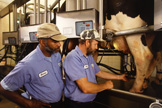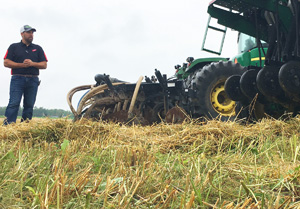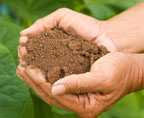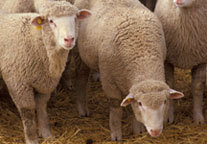Note: The use of biocontrol nematodes for the management of alfalfa snout beetle, and the depth of science behind it, was pioneered by Dr. Shields and Tony Testa with long-term funding support from the farmer-driven Northern New York Agricultural Development Program. The NNYADP was committed to finding a science-based solution for the most destructive alfalfa pest that was impacting alfalfa production and the related milk production for NNY dairy farms.
Are Persistent Biocontrol Nematodes (Entomopathogenic) an Economic Benefit for Your Northern NY Farm?
By Elson Shields and Tony Testa, Department of Entomology, Cornell University, Ithaca , NY
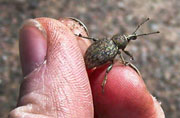
What are Biocontrol Nematodes?
Biocontrol nematodes are microscopic round worms in the soil which only attack insects in the soil or on the soil surface. These are different nematodes from the plant parasitic nematodes which attack crops. The biocontrol nematodes discussed here are native to our NNY soil where they were original collected. The nematode insect infective stage (called the Infective Juvenile or IJ) moves about in the soil in search of insect hosts, finding the insect using CO2 gradients and other chemical attractants. When an insect host is located, the IJ enters the insect through a breathing opening called a spiracle and enters the insect body cavity. Once inside, the nematode releases a bacteria which kills in insect. The nematodes then molt to adults and produce offspring on the nutrition provided by the dead insect. When the insect resources are consumed, a new set of IJs are released into the soil to search additional insect hosts. An average sized insect larvae will produce between 100,000 and 200,000 new IJs.
What Do These Biocontrol Nematodes Attack
Alfalfa Snout Beetle:
This entire technology was developed to reduce snout beetle populations to sub-economic levels within NNY. This insect is costly to the dairy farmer, commonly killing out alfalfa in a single year. The economic costs of this insect on dairy farmers is very high and often hidden. Dairy farms are impacted with the high cost of replacing alfalfa fields and the high cost of purchasing replacement feed to replace the lost alfalfa production. Estimates of these dual costs exceed $30,000 per 100 cows on the farm annually. To date, more than 150 NNY farms have applied biocontrol nematodes to >25,000 acres to successfully reduce snout beetle to a sub-economic level and increase stand life back to 3-5 years.
Corn Rootworm:
During the research developing this technology for snout beetle, it was discovered that biocontrol nematodes applied in alfalfa for snout beetle control also carryover to attack corn rootworm when the field is rotated to corn. Not only are the biocontrol nematodes completely compatible with all of the Bt-RW traits, killing the Bt toxin survivors, but in NY, the biocontrol nematodes appear to be capable of being used alone if the farmer chooses to grow non-Bt-RW traited corn. Research has shown that after 4 years of corn, the populations of biocontrol nematodes in the field are high enough to attack snout beetle when the field is rotated back to alfalfa.
Wireworm and White Grubs: Since NNY alfalfa culture usually incorporates grass into the mix, NNY fields usually have a population of wireworms and native white grubs in the field when the field is rotated to corn. Often, these insects then cause stand problems in 1st year corn. If the field has been inoculated with biocontrol nematodes for control of either snout beetle or rootworm, the biocontrol nematodes also attack these insects and reduce their impact on seedling corn when rotated to corn.
Seed Corn Maggot: With our corn and soybean insecticide seed treatments under attack, the questions arises whether biocontrol nematodes present in the soil will be effective against seed corn maggot under NY spring conditions. Seed corn maggot is killed by biocontrol nematodes in the laboratory, but the question is whether the biocontrol nematodes can work fast enough in the field under the cool spring soil temperatures.
Does the Soil Type Influence the Species of Biocontrol Nematode Applied?
NY research data indicates a mix of biocontrol nematode species gives better control of soil insects than a single species alone. The reason of these results is each nematode species has a preferred section of the soil profile where it is the most effective. For example, Steinernema carpocapsae prefers the top 2-3” of the soil profile and becomes the dominate species in this region. If S. carpocapsae is the only nematode used, insect larvae below the 2” level escape attack from S. carpocapsae. A second nematode species which prefers the low portions of the soil profile complements the presence of S. carpocapsae and gives more complete control of soil insects located below 2”. In the lighter soils, the top 2” often become too dry for a biocontrol nematode to move and attack insect larvae. In these soils, a nematode species mix which include S. carpocapsae would be ineffective.

Our recommendations for biocontrol nematode species mixes for soil types:
Clay loam – silt loam soils: S. carpocapsae + S. feltiae
Sandy loams – sand soils: S. feltiae + Heterorhabditis bacteriophora.
What are the Differences between the Entomopathogenic (biocontrol) Nematodes Purchased on the Web from the Persistent NY Strains Mentioned Here?
Biocontrol nematodes purchased from commercial sources have lost the ability to persist in the soil after application for a significant length of time. Many commercial strains persist in the soil for only 7-30 days and require application timing to be closely match with the presence of their target host and an annual reapplication is required. In contrast, the NY persistent strains of Biocontrol Nematodes are carefully cultured to maintain their evolutionary ability to persist across hostile conditions such as the lack of available hosts and temperature extremes (like winter). Additionally, NY persistent strains are re-isolated from the field every two years so the nematode cultures do not become “Lab strains”, but remain adapted for NY agricultural soil conditions. NY persistent strains are applied a single time and persist in the field for many years following application. Not surprising because they were isolated from NY soils where they have evolved for a few million years. If the NY persistent strains are cultured carelessly, they also quickly lose their ability to persist and are no better than the commercial strains purchased off the web.
How are Biocontrol Nematodes Applied?
There are two major ways to apply biocontrol nematodes to NNY fields.
Commercial pesticide sprayer: Thousands of acres have been inoculated using slightly modified pesticide sprayers of all sizes from 30’ booms to 100+’ booms. To use these sprayers, the following guidelines need to be followed.
- A good washing of the sprayer (similar to changing pesticides)
- All screens and filters removed (nematodes cannot pass through them
- Nozzle change to a stream type nozzle to shoot a concentrated stream of water to the soil surface through any vegetation.
- 50 gpa minimum
- Application in the evening or under cloudy/rainy conditions (nematodes are sensitive to UV)
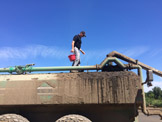
Liquid Dairy Manure: This method has been recently developed and offers some advantages over using a pesticide sprayer. The biggest limitation is that the time between adding the nematodes to the liquid manure and field application. After adding the nematodes to the manure, the manure needs to be spread in the field within 20-30 min. Longer intervals results in the nematodes dying from the lack of oxygen.
The advantages of using liquid dairy manure as the carrier are 1) no extra trips over the field, 2) can be applied any time of the day and 3) no extra costs.
Application timing:
Biocontrol nematodes which are persistent, can be applied anytime during the growing season when soil temperatures are above 50 F. Ideally, nematodes should be applied when there are host in the soil so they can immediately go to work and reproduce. However, the NY persistent strains have the ability to sit and wait for months before needing to attack hosts and reproduce. We request that no nematode applications be made after September 15th due to cooling soil temperatures and limited time to find hosts before winter. Applications are made to the soil surface under conditions of low UV exposure (late in the day, rainy/overcast days, in cover crops where there is adequate ground shading). Field tillage has no impact on biocontrol nematodes. In addition, if nematodes are applied before field tillage, the movement of soil during tillage helps the nematodes redistribute throughout the field and help them fill in the gaps which may occur during application.
Where can I get Biocontrol Nematodes that are Adapted to NY and Will Persist across Growing Seasons?
Currently, there are two sources to purchase biocontrol nematodes adapted to NY growing conditions with their persistent genes intact to persist across growing seasons (and winter) in NY.
- Mary DeBeer, Moira, NY. cell: (518) 812-8565 email: md12957@aol.com
- Shields’ Lab, Cornell University: Tony Testa email: at28@cornell.edu cell: (607) 591-1493

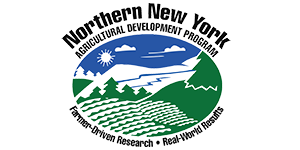 Funding for the Northern New York Agricultural Development Program is supported by the New York State Legislature and administered by the New York State Department of Agriculture and Markets.
Funding for the Northern New York Agricultural Development Program is supported by the New York State Legislature and administered by the New York State Department of Agriculture and Markets.